Article and all photos by Joe Mock, BaseballParks.com
All rights reserved
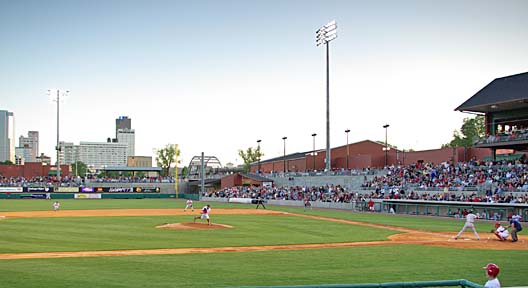 |
Two of the best parks in the Majors are PNC Park in Pittsburgh and the new Busch Stadium in St. Louis. What if you took some of the nicest elements of each of these two parks and incorporated them into a new Minor League facility?
| Ballpark Stats |
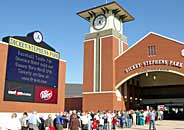 |
| Winner of the 2007 BASEBALLPARKS.COM Ballpark of the Year Read the press announcement here |
| Team: Arkansas Travelers of the Class AA Texas League |
| First game: April 12 , 2007, a 6-5 loss to Frisco |
| Capacity: 5,288 fixed seats, with room on the berms and in standing areas for another 2,500 |
| Architects: HKS Sport |
| Price: $33.6 million for construction (the land was donated) |
| Home dugout: First base side |
| Field points: Southeast |
| Playing surface: Bermuda grass overseeded with rye |
| Betcha didn’t know: The “Hook Slide Corner” beer garden is named in honor of legendary fan Walter “Hook Slide” Bradshaw |
Then you would have Dickey-Stephens Park in North Little Rock, Arkansas, the new home of the Arkansas Travelers of the Texas League. Not only that, you’d have the winner of the BASEBALLPARKS.COM Ballpark of the Year for 2007!
We were there as the ballpark made its debut on April 12, 2007. The team and the city put on quite an opening night, which was interesting because neither party had much experience in such endeavors. The Travelers hadn’t played a home game in a brand-new park since 1932, when Ray Winder Field (it was then known as Travelers Field) opened its doors. And the city of North Little Rock had never hosted pro baseball, since the previous ballpark was in a completely different town across the river.
That’s because North Little Rock is not just a part of Little Rock. No, it’s a separate, incorporated city, one that is showing up its larger neighbor across the Arkansas River, first with the impressive 18,000-seat Alltel Arena, and now with a sparkling new first-class ballpark. Truly, NLR is proving that it is a progressive city.
Little Rock had made noises a number of times about putting together a deal to construct a new home for the Travelers, but in the end, it never happened. The voters of NLR, though, came through with a vote in 2005 for a sales-tax increase that generated the funds to build a ballpark for the Travs, and the Travs were thrilled to accept the offer.
Although I don’t think it is an intentional “dig” at their former host city, an alternate version of the new home uniforms of the Travelers sport the letters “NLR” on their sleeves and caps to signify the initials of their new home town, and say “North Little Rock” across the chests.
The Travelers and the city of North Little Rock combined forces to create one of the finest facilities in Minor League baseball. Dickey-Stephens Park not only has beautiful and unique design elements, it also takes advantage of a wonderful location. Perhaps best of all, it is truly a baseball-first venue. In other words, the architects who helped shape the design of this park (HKS of Dallas) hadn’t always emphasized the baseball aspect of the ballparks they’d worked on. A good example of this is Dr Pepper Ballpark in Frisco, TX. It is as aesthetically pleasing and unique as any sports facility in the country. It is gorgeous, truly one of a kind. However, at first glance, you wouldn’t jump to the conclusion that it is a baseball facility (an upscale resort community comes to mind). Upon closer inspection, you would wonder why the bullpens are surrounded by seating sections and why the press box is so non-functional. You would admit that both are aesthetic triumphs, but not baseball triumphs.
Not so at Dickey-Stephens Park. It screams baseball … from its beautiful brick exterior to its gorgeous concourses, and from its outfield fences (not covered with “ribbon boards” like in Frisco) to its bullpens. While I do love Dr Pepper Ballpark, part of the reason it is so appealing to me is that its lush landscaping and fancy-condo-looking buildings don’t look at all like a ballpark. At the foot of the Broadway Bridge in North Little Rock, though, you know you’re looking at a baseball park — and a very, very special one at that.
Before we dive into our in-depth look at the amenities and architectural design of this incredible ballpark, I need to explain how the park received its name. After the city of Little Rock had failed to deliver on a new stadium for the Travs, prominent local businessman Warren Stephens had an idea. He had been approached about providing money for a new park within Little Rock, but none of the proposed sites excited him in the least. As he was thinking about the situation while looking out the window on the 27th floor of the Stephens Building in downtown Little Rock, he gazed across the Arkansas River and saw undeveloped property near the riverbank — land that would be perfect for a gem of a baseball park.
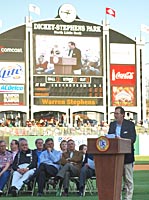 |
Stephens purchased the 11.6-acre property for $5.8 million. He then took the unusual step of donating the land he’d just bought to the city of North Little Rock. The gift carried two stipulations. First, it was to be used for a ballpark. Second, he would get to name the facility. (Later on, he would also pay a portion of the cost for the fancy scoreboard and for the opening-night fireworks. What a guy! That’s him in the photo to the right speaking at the ceremonies prior to the park’s first game.)
In August of 2005, voters in North Little Rock approved the one-percent sales tax increase for two years to pay for the construction. Stephens then provided the name the park now carries.
Dickey-Stephens Park is not, as you would assume, named after two people. No, it’s named for four individuals who, interestingly, are two sets of brothers. You see, Warren Stephens wanted the name of the park to honor the four people who’d had the biggest impact on his life:
- Bill Dickey — Yes, this is the Hall Of Fame catcher who grew up in Arkansas and later led the Yankees to seven World Series titles. He even served as interim manager for the Yanks for a stint in 1946. After he retired, he returned to Little Rock and went to work for the Stephens brothers’ investment firm.
- George “Skeeter” Dickey — Skeeter, Bills’ brother, also played in the Majors and also went to work for Stephens, Inc. after his playing days. It is interesting that Bill and Skeeter’s father worked for the Missouri Pacific Railroad, since the ballpark carrying their family’s name features a railroad theme throughout.
- Witt Stephens — Witt was the founder of the investment firm Stephens, Inc. in 1933. He forged a national reputation as one of the most powerful individuals in the brokerage business. He was also extremely influential in Arkansas politics.
- Jack Stephens — Jack was Warren’s father. He joined his brother’s firm in 1946. Not only did he serve as the company’s CEO for three decades, he was also chairman of the Masters Golf Tournament in Augusta from 1991 until 1998.
So let’s examine the special features of the Travelers’ new home, starting with its location, then moving on to its exterior, architectural design and amenities.
The Setting
If you ask someone in the Little Rock area where the new ballpark is located, they might tell you, “at the corner of Broadway and Broadway.” That’s because the land Warren Stephens donated for the park is at the corner of Broadway Avenue, which runs east-west parallel to the Arkansas River, and the Broadway Bridge, which crosses that river.
It was a brilliant choice for a ballpark. First and foremost, its location allows fans to see the skyline of downtown Little Rock beyond the right-field wall (see the photo at the top of this page — which also happens to be the very first pitch thrown in the new park). Like in Pittsburgh, the lights from the buildings make the view even more impressive as it gets dark.
The location encourages fans to park in downtown Little Rock and cross the river to get to the ballpark, just like so many fans do when they’re going to a Pirates game at PNC Park. In this instance, though, instead of crossing the Allegheny River on the Roberto Clemente Bridge, Travs fans are strolling across the Arkansas River on the Broadway Bridge. As the photo below illustrates, you get a wonderful view of the new park from the bridge, just like you do in Pittsburgh.
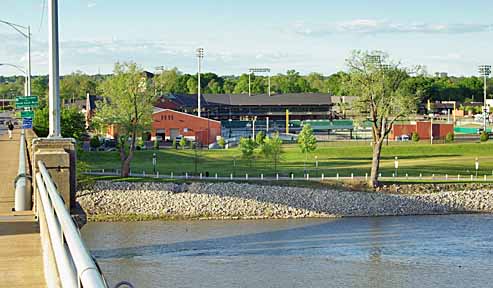 |
Even though the location is virtually on a riverbank, the area surrounding the park is largely residential — although North Little Rock’s more commercial area is just a few blocks to the east. While there’s a parking lot — that charges $3 — just to the west of the park, there is a great deal of free parking in that commercial area. As long as an event isn’t going on at the Alltel Areana, there are two 300-space lots with free parking three blocks from the ballpark. Note that parking isn’t techncially free in the neighborhoods just north of the park. That’s because the city has just implemented a plan that requires that you have a permit before you can park on those streets. That’s fair, because otherwise the residents of that neighborhood wouldn’t be able to park in front of their own houses on game nights.
The Exterior
You don’t have to spend much time at Dickey-Stephens Park to realize that there is a “theme” at work here. Because North Little Rock was a vital railroad town dating back to the mid-Nineteenth Century, a “train” theme is carried out beautifully throughout the facility, and that includes the exterior.
While there’s nothing new about using brick for the outside of a baseball park, the way it’s done here is beautiful — in much the same way as in the Cardinals’ new Busch Stadium. While never straying far from a look that says “this could just as easily be a train station as a ballpark,” the brick exterior at Dickey-Stephens is expertly done. I also really enjoyed the way tile work was incorporated in some of the vertical structures, such as the clock tower that dominates the look of the main entrance to the park.
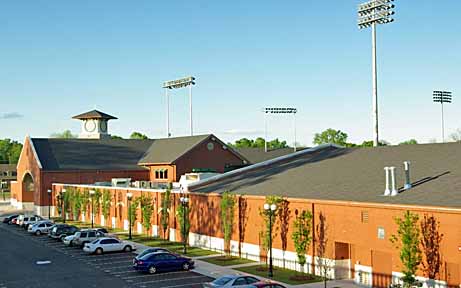 |
Above we see the western end of the facility from the foot of the Broadway Bridge. This part of the project contains both clubhouses, as well as several meeting rooms where groups can hold pre-game get-togethers.
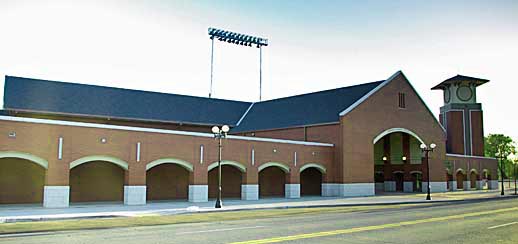 |
This shot shows the northern exterior of the park along Broadway Avenue. Here you really see the train-station look, as well as the clock tower at the far right of the shot. That clock tower, in addition to being reminiscent of something you’d see at an old train depot, is a brilliant design element, since it breaks up the rather level roof line of the structure. This has the added benefit of creating a unique look to the seating bowl from inside the park. That’s because if you stand on the berm in the outfield at virtually any recently built Minor League park, and you stare at the structure above the seats around the infield, it is often difficult to distinguish one ballpark from another. Not here. That tower makes Dickey-Stephens Park quite unique.
The Design
The architectural firm behind the design of North Little Rock’s new park is HKS Sport in Dallas. Not only were they involved in the Texas Rangers’ park that opened in 1994, they also designed the new football stadiums for the Cowboys and Colts that are under construction now. In addition, HKS was behind three outstanding Minor League baseball parks in Texas (Round Rock, Corpus Christi and Frisco — although at Frisco, David M. Schwartz of Washington, D.C. came up with the concept of the park’s layout), plus they designed the significant renovations to both U.S. Cellular Field in Chicago and LA’s Dodger Stadium. Dickey-Stephens just might be HKS’s finest baseball work, though.
When I visited Whataburger Field in Corpus Christi for the first time, I was struck by how HKS’s design made improvements over their previous ballparks. For instance, fans love to be able to walk comfortably to and from concession stands and restrooms, while still being able to see the field. In Round Rock, there is a concourse that allows you to do this, but it isn’t nearly wide enough. The wider concourse runs parallel to this one, but because it is outside the concession stands and such, the field isn’t visible at all. Also in Frisco, there are concentric walkways, and the ones that lead you to the restrooms and, until 2007, the souvenir shop, are completely isolated from the field. This was all rectified at Corpus, as the inner concourse is incredibly wide.
The same can be said of Dickey-Stephens Park — perhaps to an even greater extent. These “open” concourses allow the throngs to pass by one another comfortably, and when there are long lines at the concession stands (which were understandable on opening night), there is still room to navigate around them.
 |
And this concourse leads you to everything you’d want to visit — the lovely information kiosk near the main gate, the spacious (well, compared to the one at Ray Winder Field) souvenir shop, numerous concession stands, a full-service restaurant, a small museum devoted to the history of baseball in central Arkansas, beautifully appointed restrooms (and unlike at Ray Winder Field, no troughs!), the right-field beer garden and the picnic areas.
That concourse can also take you on a trek all the way around the ballpark. And like the highly rated parks in Memphis, Corpus Christi, Albuquerque and many others, this is a 360-degree trip that you should definitely take. There are many, many wonderful vantage points from which to take photos or to just enjoy the overall look of Dickey-Stephens.
At one point on your journey around the park, you’ll cross a bridge of sorts that passes over the “driveway” that allows vehicles to get to the field (below left). This bridge fits with the railroad theme of the park, as it resembles a structure that would carry a train across a river.
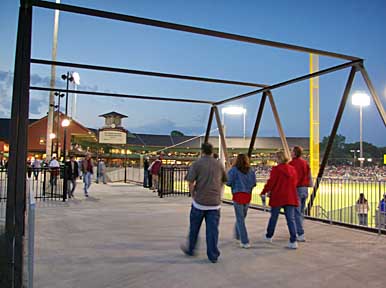  |
The entryways are also remarkable here. In my review of the Cardinals’ new Busch Stadium, I pointed out the phenomenal entryways that HOK had designed. Because of that park’s proximity to the Mississippi River and the historic Eads Bridge that crosses it, the third-base gates resemble the beautiful steelwork on that bridge. Here at Dickey-Stephens, the three main entrances have similar high, arching ceilings (above right), but instead of looking like an ornate St. Louis bridge, the effect adds to the railroad-station look of the park.
The bullpens are positioned in an interesting way, too. They are end-to-end running along the outfield fence in right field. This also causes a variance in the height of the wall, as it is only four feet high in front of the bullpens, but it’s eight-and-a-half-feet tall everywhere else.
There are also two “see-through” aspects of Dickey-Stephens that you don’t usually find at a ballpark. The wrought-iron fence that separates the left-field concourse from the outside world allows those without a ticket to peer in at the action (below left). This is reminiscent of the right-field fence at AT&T Park in San Francisco. Also, the backstop is like none I’ve ever seen. The screen between the playing field and the first row of seats stretches all the way to the ground (below right).
  |
Finally, the architects — with the input of Travs broadcaster Phil Elson — created an outstanding press box. It is both spacious and functional, which cannot be said of the one in Frisco.